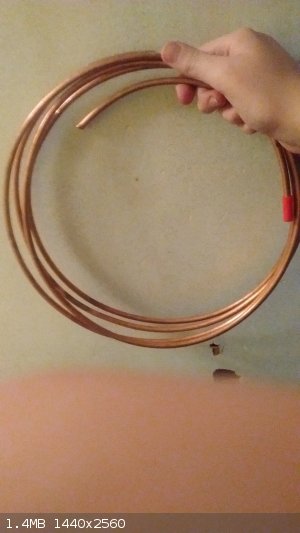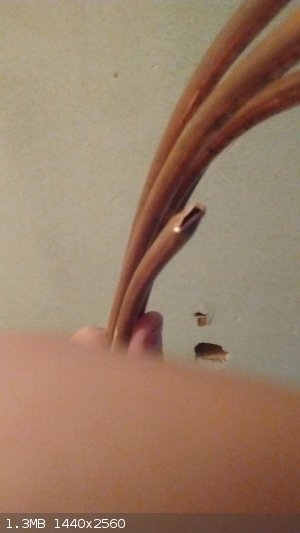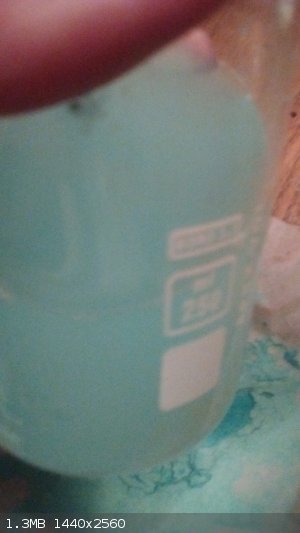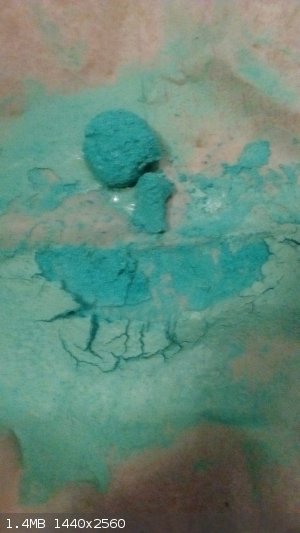Clonejeffie
Harmless

Posts: 31
Registered: 21-2-2017
Member Is Offline
Mood: Curious
|
|
Products of MgSO4 electrolosis and separation
I recently electrolyzed some MgSO4 with copper electrodes. The positive electrode disolved forming a green precipitate and a dark gray substance was
deposited on the negative electrode. I would like to know how to separate the products.
|
|
|
macckone
Dispenser of practical lab wisdom
    
Posts: 2168
Registered: 1-3-2013
Location: Over a mile high
Member Is Offline
Mood: Electrical
|
|
The gray substance is probably MgO.
The green substance is a copper complex.
The copper complex will be somewhat soluble.
You probably have a greenish to bluish solution as well.
It will also contain a copper complex.
This is going to be a pain to separate.
|
|
|
AJKOER
Radically Dubious
    
Posts: 3026
Registered: 7-5-2011
Member Is Offline
Mood: No Mood
|
|
Your copper is not likely pure. See http://www.isri.org/docs/default-source/commodities/specsupd...
Gray is likely an Al2O3/Al impurity or other metal.
The green is dilute CuSO4.
----------------------------------
I once slowly created some dilute CuSO4 using electrodes of copper and graphite in a solution of MgSO4. The latter carbon electrode broke down to form
carbon particles polluting the solution. I solve this problem by placing the graphite rode in a funnel with a filter resting in larger vessel filled
with aqueous MgSO4. In essence, I created a bridge (actually a funnel) in a divided cell, where exterior to the funnel was the copper electrode with
an aqua blue CuSO4 solution developing in time.
[Edited on 2-3-2017 by AJKOER]
|
|
|
Clonejeffie
Harmless

Posts: 31
Registered: 21-2-2017
Member Is Offline
Mood: Curious
|
|
AJKOER The copper was water tubing but there might be impurities in the Epsom salt. What would carbon electrodes purpose be?
|
|
|
Clonejeffie
Harmless

Posts: 31
Registered: 21-2-2017
Member Is Offline
Mood: Curious
|
|


|
|
|
Clonejeffie
Harmless

Posts: 31
Registered: 21-2-2017
Member Is Offline
Mood: Curious
|
|

|
|
|
Clonejeffie
Harmless

Posts: 31
Registered: 21-2-2017
Member Is Offline
Mood: Curious
|
|

|
|
|
AJKOER
Radically Dubious
    
Posts: 3026
Registered: 7-5-2011
Member Is Offline
Mood: No Mood
|
|
There is one copper electrode (half cell reaction at positively charged anode: Cu ---> Cu2+ + 2 e-) and one inert carbon (used graphite) electrode
(half cell at negatively charged cathode: H+ + OH- + e- ---> H + OH-) which further reacts with the aqueous MgSO4 solution as follows:
Mg+ + 2 OH- ---> Mg(OH)2 (s)
We are left with aqueous Cu2+ , SO4(2-), a white precipitate of Mg(OH)2 and hydrogen gas (as H + H --> H2 ). The net cell reaction is:
MgSO4 (aq) + 2 H2O + Cu (s) ---> Mg(OH)2 (s) + CuSO4 (aq) + H2 (g)
Remember, as I noted above, I used a funnel as a bridge, creating a divided cell, due to the carbon break down at the graphite electrode.
Also, if the electrode generating OH- is not inert but copper, some Cu(OH)2 will form. In place of the inert graphite electrode, one can also try
stainless steel (I have used tableware marked as stainless steel). However, if a rust colored solution develops, evidently not inert enough.
[Edited on 3-3-2017 by AJKOER]
|
|
|
DFliyerz
Hazard to Others
  
Posts: 241
Registered: 22-12-2014
Member Is Offline
Mood: No Mood
|
|
The precipitate is probably mixed copper and magnesium hydroxides.
|
|
|
PirateDocBrown
National Hazard
   
Posts: 570
Registered: 27-11-2016
Location: Minnesota
Member Is Offline
Mood: No Mood
|
|
Separating copper from magnesium is not difficult.
Re-solubilize them with HCl, then bubble in H2S. Copper sulfides precipitate out, Mg remains in solution.
|
|
|
Clonejeffie
Harmless

Posts: 31
Registered: 21-2-2017
Member Is Offline
Mood: Curious
|
|
what power to use?
|
|
|
Melgar
Anti-Spam Agent
    
Posts: 2004
Registered: 23-2-2010
Location: Connecticut
Member Is Offline
Mood: Estrified
|
|
If you want to separate them, just acidify the solution with HCl or H2SO4, then drop in a piece of zinc. Copper will plate onto zinc, but Mg will
stay in solution. Once you have plenty of wet copper powder, just redissolve that.
|
|
|